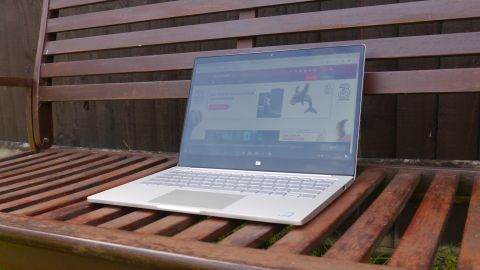TechRadar Verdict
The Mi Notebook Air 13.3 is a fantastic laptop let down by a few niggles like the noisy cooling system and the lack of an English version of Windows 10. Aftersales is where its biggest weakness lies, though.
Pros
- +
Superb design
- +
Fingerprint reader
- +
Impressive performance
- +
Dedicated GPU
Cons
- -
Average battery life
- -
Above average noise levels
- -
Chinese version of Windows 10
- -
No SD card reader
Why you can trust TechRadar
Note that we’ve reviewed the latest 2018 version of the Xiaomi Mi Laptop Air 13.3 here
Remember the sublime Xiaomi Air laptop we reviewed last year? Well, the Chinese manufacturer, better known for its smartphone range, has refreshed its entire 12.5 and 13.3-inch range (and introduced a gorgeous 15.6-inch Pro range) with a clear eye on the lucrative prosumer/business audience.
Online Chinese retailer, Gearbest, sent us the sample and sells the Xiaomi Mi Notebook Air 13.3 laptop for just over £745 ($1036) at the time of writing with the discount coupon GBTPC (which expires April 30). There is a cheaper 128GB version available as well. Note that, while this price includes delivery, it is exclusive of any taxes that may be levied by HMRC or the courier companies on behalf of the vendor. Want to buy tech from online Chinese retailers? Read this first.
Available in gold or silver color schemes, the Xiaomi Mi Notebook Air 13.3-inch model comes as a Fingerprint Edition – which we are reviewing today – and a Classic Edition. The latter is simply the renamed older 2016 model which uses older components and lacks the fingerprint reader, but at the same time has a much lower price tag (as little as £540 – that’s around $730).
Design
The first thing you notice is the lack of any logo on the top side of the laptop – there’s simply an inconspicuous stylized MI logo underneath the chassis with stickers bearing useful printed details. You can peel them off to leave the device totally devoid of any distractions.
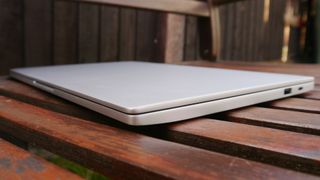
Xiaomi stuck to the minimalist design embraced since the beginning of the Air era. The machine has a brushed metal finish on an all-metal enclosure, sharper-than-average edges and an evident disregard for super-thin designs.
There’s no visual trickery here (no tapered profile/wedge as seen on the likes of the Jumper EZBook 3 Pro); this laptop looks like an almost perfect metal slab.

As with Apple laptops, there’s a chamfered cut and a long, centrally located metal hinge that links the base to the display. Flip it upside down and you’ll see five rubber feet, six screws that keep the base together, and two speaker grilles.
The Xiaomi Mi Notebook Air 13.3 is slightly bigger than an A4 sheet (309 x 211 x 14.8mm) and weighs a chunky 1.31kg with the power supply adding another 223g.
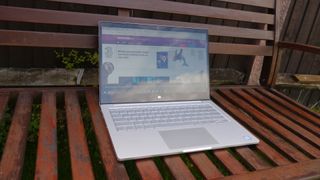
When open, this model shares the same look as the Xiaomi Air 12 we reviewed last year. Of course, it has a slightly bigger IPS display with a 1920 x 1080 pixel resolution, a glossy glass overlay – which seems to have an oleophobic coating – and thin bezels. We’d prefer a matte finish especially as the Xiaomi Air 13.3 doesn’t offer any touchscreen capabilities.
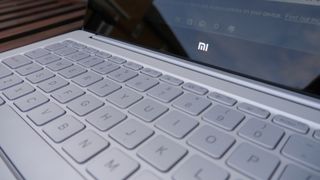
The keyboard subjectively rates on par with the likes of the Dell XPS 13. There’s ample spacing between the keys, and they are big – a full 2mm bigger, at 16mm, than the ones on the aforementioned Dell laptop. They offer a good amount of travel with little flex.
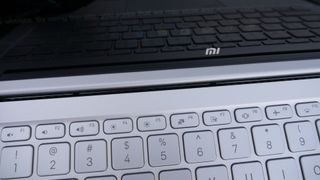
A few observations: the function keys are about half the size of the normal alphabetical keys. The power button is located on the top right-hand side of the laptop. The keyboard is backlit but doesn’t offer an intermediary ‘medium’ light setting.
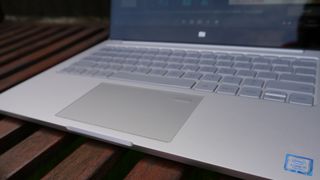
The touchpad is generously sized at 110 x 67mm; it has no physical buttons and comes with an integrated fingerprint scanner.
There are three ports on each side: an HDMI port, USB 3.0 and earphone jack can be found on one side, and a USB 3.0 along with a USB Type-C port on the other. The latter also doubles as the power port (so you can’t use it when plugged into the mains).

Here is the Xiaomi Mi Notebook Air 13.3 configuration sent to TechRadar Pro for review:
CPU: Intel Core i5-7200U (dual-core, 2.5GHz, 3MB cache)
Graphics: Intel HD Graphics 620, GeForce MX150 with 2GB GDDR5
RAM: 8GB DDR4 (2133MHz)
Screen: 13.3-inch FHD display
Storage: 256GB M.2 Samsung PM961 SSD
Ports: 1 x USB 3.0, 1 x USB 3.0 w/PowerShare, USB Type-C, audio jack, HDMI
Connectivity: Intel Wireless AC 8265 (802.11ac Wi-Fi, Bluetooth 4.1)
Camera: 1MP HD webcam
Weight: 1.31kg
Size: 309 x 211 x 14.8mm (W x D x H)
Warranty: 12-months
Battery: 39.2Whr/5.4Ah
Specifications
Xiaomi went for the very best components (well, at least they were a few months ago, anyway) for this laptop. The 256GB model we received runs the Samsung PM961 M.2 NVMe SSD, one of the fastest laptop drives currently available.
The 7th-generation Intel Core i5-7200U is not as powerful as the just-released i5-8250U but it still delivers a powerful punch: it has two cores, four threads, a maximum turbo frequency of 3.1GHz and 3MB cache.
The on-board comms chip has also been upgraded to the Intel Wireless AC 8265.
The big improvement, however, comes from the on-board Nvidia GeForce MX150 GPU, which is based on the Pascal architecture and is said to deliver up to 37% extra gaming performance compared to the 940MX.
The MX150 also supports Optimus technology which allows applications to switch seamlessly between integrated and dedicated graphics to save battery life when the latter isn’t needed.

Désiré has been musing and writing about technology during a career spanning four decades. He dabbled in website builders and web hosting when DHTML and frames were in vogue and started narrating about the impact of technology on society just before the start of the Y2K hysteria at the turn of the last millennium.
